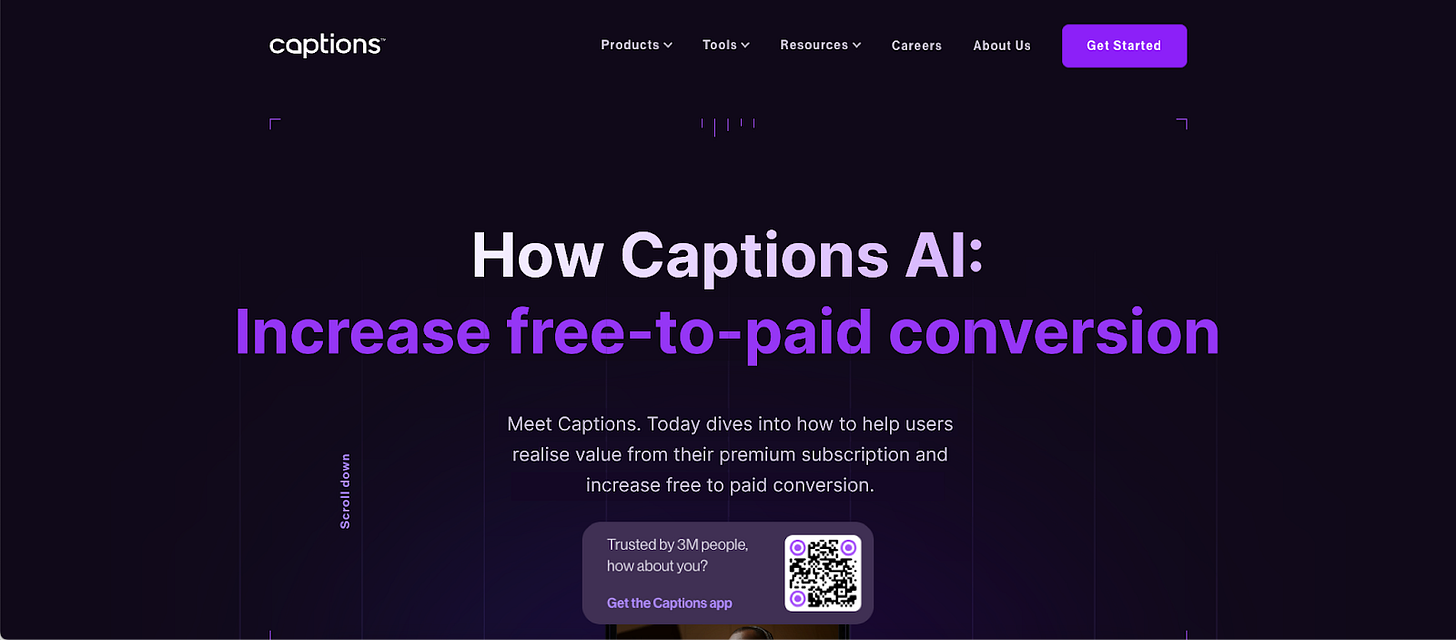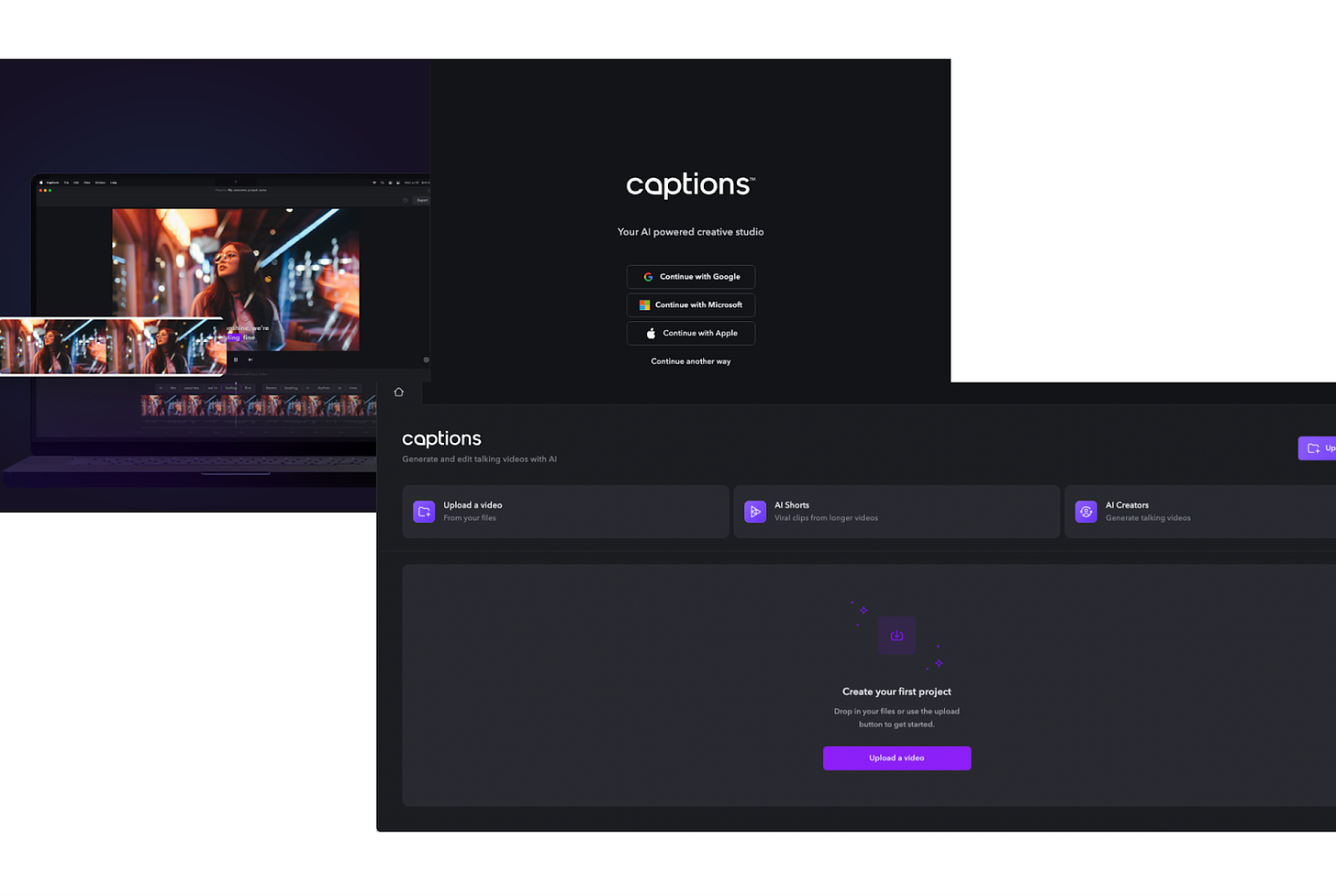How Captions AI Increase Free-to-Paid Conversion in a Saturated Market
4 Free-to-paid conversion Saas tips
👋 Henry here, welcome to B2B Growth Insights, where I take my learnings from being at Pricepoint Partners to showcase how the best B2B SaaS companies do monetisation, unique top of funnel strategies, and funnel optimisation.
Recommendations from today’s article:
🗺️ Lost Users: Breaking down Captions AI’s current onboarding flow and how it’s lacking any form of direction leading to users getting lost & confused as to how to start.
⏰ Instil Urgency w/ One Time Offers: A super simple UX tip on how to increase your conversions to your premium plan within onboarding to cut your payback period by 60%.
❌ Don’t be too pushy with paywalls: We explore a concept for how to make users feel great about themselves whilst skyrocketing your conversion rate to premium with a weekly recap.
Who are Captions AI?
Captions AI launched in 2021 by Gaurav Misra and Dwight Churchill allowing users to easily edit short form video clips for social media. They’ve done exceptionally well building out a product for prosumers and team use cases with a freemium business model increasing accessibility and enabling individuals to experiment with the product.
Captions AI’s differentiation comes from lowering the barriers to video editing with templated AI-powered actions such as AI speech correction, AI eye contact and AI video trimming - actions that normally would take hours of manual work on a desktop.
However, despite their product strengths, like many other freemium products it means their company has a weaker handle on getting people to upgrade.
Their single player utility enables a great land-and-expand motion but doesn’t negate the difficulties around profitably acquiring customers via paid ads for a single seat SaaS subscription, let alone a free product with costly AI expenses.
This issue won’t change with Facebook & Google CPMs always rising so today we’re going to dig into what Captions could do to better convert free users to paid plans and reduce payback periods from 12 months to less than 30 days with effective monetisation.
Suggestion #1 - One Time Trial
Captions’ sign up flow is remarkably simple. You sign in with your method of choice (e.g. Google/Apple) and then you’re in. No asking for your name, what types of features you’re looking for or your level of experience in editing.
This is wild to me! As they’ve grown they’ve naturally had to expand to serve several different ICPs with different use cases and knowledge levels but there’s no personalisation? There’s not even a set of steps they recommend you to complete to finish your first video editing project.
This means there’s likely a huge amount of dropoff after people’s first usage of the app.
To counter this one thing I might do is a little counterintuitive, add friction. As I’ve said many times your revenue increases almost linearly to the number of paywalls you show to a user of their lifespan meaning it’s pretty imperative to get started early with a paywall in onboarding.
One way we’ve discussed before is to not expect that many will convert on this first paywall but instead is used to anchor a user’s perceived price of the product higher so when you offer a discount it seems like a steal.
Another way, however, is to offer a one time trial in onboarding. This somewhat alleviates the issue of users never coming back because you ensure everyone sees it and by giving them a trial or getting users to pay for a cheap plan actually increases commitment to the product.
This can work really well. Users have their highest excitement levels when just getting started and in the case of Captions likely have a great deal of motivation to start video editing. The one time nature of the trial within signup creates a natural sense of urgency and could be super effective in boosting not only activation rates but also ARPU.
We’ve talked before about how to optimise paywall conversion in the Blinkist article, letting user’s know they’ll receive an email before their trial is set to expire.
What might all this look like?
✅ Urgency: Let users know this is a real one-time offer, exclusively for users who are just signing up.
✅ Warn Users Before a Trial Ends: One main fear users have is that they’ll forget to cancel. Reassure users they’ll get an email before it expires and you’ll get their appreciation and willingness to consider a premium trial.
Suggestion #2 - Better Illustrate Value
Now we get into the main Captions product. It is undeniably very impressive. You upload a video and will see one-click actions that would have previously taken hours of manual work. The problem, however, is that AI is very computationally intensive which these actions take a while to finish.
Currently Captions leaves you in purgatory, simply waiting with a scroll wheel until the AI has worked its magic. Whilst these wait times are typically something applications desperately work to minimise the other solution is to help users realise just how much is going on under the hood.
This approach was pioneered by the airline search industry where by using animations that explained the processes going on behind-the-scenes, searching all the airlines to find you the best deal it reduced the perception of waiting and massively increased the value of their service.
This is now called ‘The Labour Illusion’ explaining why people view products more favourably when they learn of the effort that was put in to deliver results.
2 Ways to Reduce the Perceived Wait Time
✅ Highlight Effort: Inform users of all the work the AI model is doing to help you add captions, adjust your speech or automatically edit the video.
✅ Display Social Proof: The other solution is to use this time to show the value your app has created for countless others. The most successful example of this is Duolingo.
Suggestion #3 - Upsell Annual Plans
Something I’ve stressed with this newsletter many times before is the value in getting users to convert to annual plans. Annual plans see far lower churn, allow the user more time to find value in the product and build up switching costs. The results? Significantly higher LTV’s over time.
This has even greater importance for PLG and prosumer tools like Captions where churn is one of the biggest roadblocks to consistent growth. Whilst B2B SaaS contracts may typically last 2-4 years prosumer apps typical lifetime values are in the 4-6 month range.
The other key benefit is annual customers improve cash flow to a massive degree. While payback periods from typical paid ad campaigns may be 9 months, a conversion to annual can often mean a payback period less than 30 days even with a heavy incentive.
The importance of this cannot be overstated. Say in the normal case 10% of people convert to annual when signing up. If you are instead able to convert 60% of users to annual in the first month (Duolingo gets 75%) this cuts your payback period in half and allows you to reinvest your marketing budget again 2x as fast.
To boost their annual subscription numbers every user should have an easy, one-click toggle upselling them on the annual plan at checkout.
Save $XX or get X months free is a great incentive for people to switch and clearly articulates the value for people vs a XX% offer where users have a tough time quantifying the savings in their head (how much is 15% off a $108 plan).
Suggestion #4 - Reinforce Value of Premium
But not everyone is ready to pay on Day 1. One of the two most effective ways to increase subscription conversions is to regularly reinforce the value of your product. It may be easy for a user to overlook the benefits of a free product so remind them of how many hours they’ve saved with AI actions like eye correction.
Better yet highlight how many videos they’ve managed to finish editing and compare it with last week or last month.
This does a great job of subtly reminding users of the value Captions delivers, and instead of being pushy with a paywall you get to make them feel great by celebrating their progress. Users remember how you make them feel, if they feel like a rockstar because of you they’re going to stick with you for years.
That’s it for today folks. If you found this article helpful and would like to get some insights into how your business could improve its UX and monetisation book in a call with me. I’d love to have a chat!














